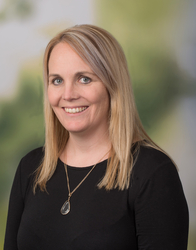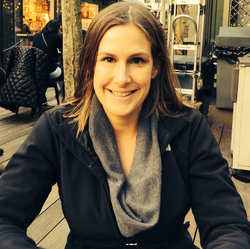The nurses at Bon Secours St. Mary’s pediatric lung clinic were puzzled. A mother kept bringing her child in because of asthma attacks, even though the boy was regularly taking his prescribed medications. The nurses wanted to know if there was anything going on in the child’s life that might explain the attacks, says Blair Bell, a pediatric specialties nurse manager who oversees the lung clinic and five other pediatric clinics affiliated with St. Mary’s.

“After talking to the boy, they learned that he was witnessing abuse between [the two adults] in his household, and that was affecting his asthma and his breathing,” she says.
The clinic connected the boy and his mother with a social worker and some mental health support, which eventually enabled them to move to a safer situation. After the move, the child’s asthma attacks and breathing flare-ups ended.
Fortunately, the nurses had been trained in trauma-informed practices, which is why they were able to take such a comprehensive view of the situation. Before that, Bell says, they likely wouldn’t have had the tools to go beyond thinking that any patient with similar symptoms was “non-compliant,“ or not fully following the recommendations of his health care providers.
This shift is an example of what’s been happening bit by bit in two separate large health systems in Richmond, Virginia, Bon Secours Richmond Health and VCU Health, which together serve a good portion of the Greater Richmond population. This story focuses on Bon Secours St. Mary’s Hospital and how Bell and a growing team have been working to ensure that the hospital staff recognize how widespread trauma is among patients and staff alike. A trauma-informed approach to care also includes recognizing behavior that may stem from trauma, learning ways to de-escalate that behavior, and preventing practices that trigger patients who have experienced trauma.
Since 2018, more than 100 nurses with Bon Secours St. Mary’s have been trained in such an approach. They work in labor and delivery, general pediatrics, pediatric intensive care, and the pediatric emergency department. And while they’re still in the process of streamlining their methods -- such as how they question survivors of abuse and how they respond to patients who exhibit disruptive behaviors -- they’re now fine-tuning their curriculum to offer trauma-informed care to the entire staff at St. Mary’s and throughout the Bon Secours Health System, which includes seven hospitals in the Greater Richmond area. Today, St. Mary’s has its own 24-member trauma-informed leadership team.
Bell speaks bluntly about why she thought there was such a need: “Sometimes the work we do may elicit negative or undesirable reactions. We must be able to assist patients in ways that don’t re-traumatize them.” And Bell is well aware that trauma also figures in the lives of those who are providing care. “We must have the ability to recognize when staff need extra support or interventions to help build resiliency,” she says.
The work they’re doing isn’t happening in a vacuum. The St. Mary’s trauma-informed leadership health team is part of the health committee of the Greater Richmond Trauma-Informed Community Network (GRTICN).

Melissa McGinn, the coordinator of the GRTICN, was an instigator in getting the two hospital systems on board with trauma-informed care. She knew that although they were competitors, they already had a track record of collaboration that had enabled Richmond to go from being the worst city in in the country for pediatric asthma in 2009 to a slightly better 12th place currently. To persuade the two hospital systems to implement this approach, she decided to start with pediatrics as an area providers could come together on—and it worked. “They gave us their blessing,” she says.
But the clincher was focusing on how trauma-informed practices were not just for patients, but also for health care providers, who often come to work with their own history of trauma. If left unchecked, she explained in that first meeting in March 2018, their stress can “spill over and play out in interactions with other staff or with patients, or in their needing to take more sick days for physical or mental health issues.” Her pitch also included showing how widespread childhood trauma is in the general population, based on the ACE Study and subsequent research.
But after several months went by, McGinn saw that the hospital CEOs weren’t moving forward. “We know from best practices that leadership has to be invested and involved to create lasting change,” she says. So she tried another tactic. She identified champions within Bon Secours Health and VCU Health who had been attending GRTICN meetings and helped them organize trauma-informed leadership teams.
Enter Blair Bell, who attended the first meeting of the health committee of the GRTICN in the fall of 2018. There, she learned about the landmark Centers for Disease and Control/Kaiser Permanente ACE Study and trauma-informed care. She was hooked. The ACE Study “gave us the research that explained what’s behind the ‘non-complaint’ labels that we were assigning to some of these kids,” she says. It also provided a roadmap to address these issues as a medical team.
ACEs is short for adverse childhood experiences. The ACE Study of more than 17,000 adults linked ACEs to the adult onset of many chronic diseases, mental illness, violence and being a victim of violence . The study found that ACEs are remarkably common — most people have at least one. People who have four or more different types of ACEs — about 12 percent of the population — have a 1,200 percent higher risk of attempting suicide and a 700 percent higher risk of becoming an alcoholic, compared with people who have no ACEs.
The epidemiology of childhood adversity is one of five parts of ACEs science, which also includes how toxic stress from ACEs affects children’s brains, the short- and long-term health effects of toxic stress, how toxic stress is passed on from generation to generation, and research on resilience, which includes how individuals, organizations, systems and communities can integrate ACEs science to solve our most intractable problems.
Bell was so taken with the potential of trauma-informed care to transform the hospital environment that making it happen became the focus of her doctoral dissertation in nursing. For her thesis, she developed a survey and held focus groups to find out if her fellow nurses in pediatrics at St. Mary’s had any idea what trauma-informed care meant or had heard about the landmark ACE Study.
“The thing that really stuck out to me was that a lot of people didn't know what trauma-informed care was at all,” she recalls. Bell provided the basics, using the ACE Study to show the links between trauma and health outcomes, how trauma affects the brain and behavior, and how interventions can support people who have experienced trauma. She also shared how to build resilience.
Bell’s research also included asking her peers about what practices and policies in the hospital may be retraumatizing for someone with a history of trauma. One clear example involved interactions with survivors of abuse.
“As mandated reporters, we ask a lot of questions, and people realized that we need to be careful about how we’re asking and how many times we’re asking questions about [their experiences],” she said. A group from the St. Mary’s trauma-informed leadership team is working with the hospital IT team to incorporate patients’ responses into electronic health records, so survivors don’t have to be asked the same question multiple times.
Another realization that surfaced from her focus groups was that children might be retraumatized by certain repetitive questions asked about their families. “Children may have lost family members. So they might be in the hospital with a grandparent. And instead of [health care staff] asking, where are the parents, who may have been in some traumatic situation and lost their lives, they suggested that we read each other's nursing notes to make sure that we have the whole picture versus constantly asking the same questions.”
The focus groups of nurses also reflected on their physical surroundings. They noted that the signs in the hospital might be triggering to patients.
“During that time there was some construction going on, and there were fewer signs to help people navigate through the hospital. So patients were likely feeling very lost and unable to navigate through certain areas.” The construction has since been completed, and the signage issue was resolved.
McGinn, who helped run focus groups for Bell’s dissertation research, recalls that nurses identified a common stressor among peers and a simple way to resolve it. Often, if a patient passed away or another significant event occurred on the floor, the nurses would feel sadness—but nurses just coming onto the shift wouldn’t be aware of what had happened. “So they started putting a little tea light at the nurses’ station. If you’re coming on the floor and see that, it means something significant happened, so you may need to come in with a calm demeanor and realize that some people may need extra support.”
Last December, Bell learned that a sister hospital, Bon Secours St. Francis, also had been moving the needle on trauma-informed care, including training staff in activities that build resilience. They joined forces and started meeting to share ideas and training. (Stay tuned for a story exploring the trauma-informed work at St. Francis.)
Bell also had the opportunity to use some resilience-building techniques she had learned in a recent exercise with nurses in St. Mary’s pediatric hospice and palliative care clinic. “Unfortunately, we have had some really hard situations and several deaths recently,” she explains. Bell led the team through deep breathing exercises and also had them select words cut out from magazines that “spoke to them.” They selected words that reflected both how they are feeling, how they felt after they had taken some time as a team to be quiet and relax, and what activities help them recharge.
Bell and other nurses also use deep breathing and other sensory techniques to help calm their young patients who are triggered—offering them a popsicle, or a hot cup of tea, or fidget toys.
St. Mary’s is now working on a larger plan with Bon Secours to train health care providers throughout St. Mary’s and the seven hospitals in the Bon Secours system in trauma-informed practices. She says she expects the training curriculum to be completed at the beginning of next year and rolled out by midyear.
Bell is ready for the next move. But for now, she says, she feels like she achieved what she originally set out to do. “People are very aware of the impact of trauma, and I think just having that awareness is huge.”




Comments (0)